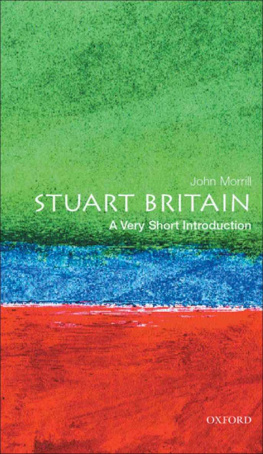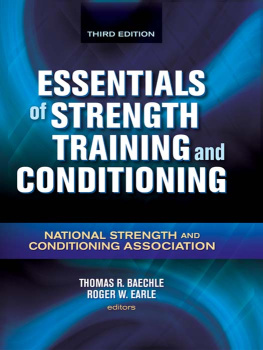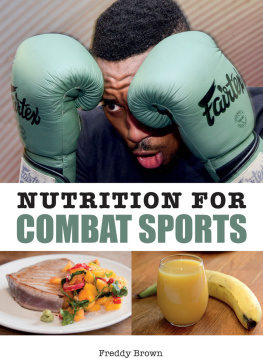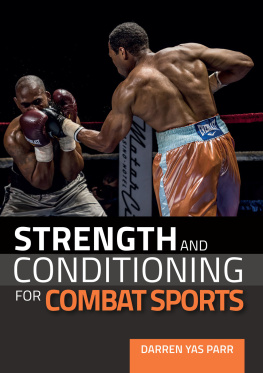The Combat Sports STrength And Conditioning Manual
Minimalist Training for Maximum Results
Will Morrill
The Combat Sports Strength and Conditioning Manual
2018 Will Morrill. All rights reserved.
For more information visit combatsportsmanual.com
Password for extra content: FIGHTSTRENGTH
Book Cover Design: Marissa Torre
Cover Photo: Ronin Advertising
Pictured on Cover: Will Morrill and Iron City Mike Wilkins
Editors: Ben Major and Marissa Torre
Neck Strength Photos: Quinn Jordan
ISBN : 9781792616365
The information in this book is for educational purposes only and is not intended as a substitute for individual health and fitness advice. You should be in good physical condition before beginning this or any other exercise system. The author is not a licensed practitioner, physician or medical professional and offers no medical treatments, diagnoses, suggestions or counseling. The information presented herein has not been evaluated by the U.S. Food and Drug Administration, and is not intended to diagnose, treat, cure or prevent any disease. Full medical clearance from a licensed physician should be obtained before beginning or modifying any diet, exercise or combat sports program, and physicians should be informed of all nutritional changes. The author claims no responsibility to any person or entity for any liability, injury, loss or damage caused or alleged to be caused directly or indirectly as a result of the use, application or interpretation of the information presented herein.
Acknowledgements
I would like to thank:
Warren Stout and Mike Wilkins for elevating my understanding of MMA and giving me all of the opportunities that you have.
Bob Meese for showing me the intricacies of boxing in MMA.
All the MMA, Muay Thai fighters, and team members at Stout Training Pittsburgh for the hard work and dedication you have put into the fight game.
My college coaches David Vacco, Os Omo-Osagie, and the late Jack Rorabaugh for teaching me how to box.
My Tang Soo Do instructor DeWayne Adams for showing me where traditional martial arts overlap with fighting and how they differ, as well as for introducing me to lifting weights.
John Swisher from Ronin Advertising for sending me all the great photos.
My parents, family and friends for putting up with all this fighting nonsense for so many years.
Marissa for designing the cover, website, and supporting me through the whole writing process.
Table of Contents
Chapter 1
Introduction
The mission of this manual is to provide quality information about strength training to the coaches and athletes who dedicate their lives to combat sports. Combat sports have often sat on the back burner of society in the United States, while arguably more violent sports such as football and hockey have flourished. Many factors separate combat sports from the major big money sports, and one small way to help close the gap and elevate the standing of combat sports is to bring the high level strength and conditioning training from other sports over and apply it intelligently. At the college and sometimes even the high-school level, team sports have designated strength and conditioning coaches, designing programs to increase athletic performance, help prevent injuries and boost mental strength and confidence. In contrast, even today, coaches in combat sports often perpetuate old myths like, Lifting will make you muscle bound and slow.
As to methods there may be a million and then some, but principles are few. The man who grasps principles can successfully select his own methods. The man who tries methods, ignoring principles, is sure to have trouble. Harrington Emerso n
The exact system outlined in this manual is not particularly important, but the principles it is built upon are extremely so. While many years of experimentation and lots of thought has gone into the development of this system, I have boiled it down to four basic principles that will be unpacked in further detail.
- Minimalist Training
- Hierarchy of Physical Attributes
- Adaptability
- Sustainability
The concept of minimalist training has been called many things: the minimax principle, minimum effective dose, the 80/20 principle, etc., but they all refer to the same idea that we should accomplish as much as possible in the least amount of time as possible while using the least amount of energy as possible. This is particularly important in combat sports training, especially MMA, which most of this manual will concern itself with. Skill is generally more important than strength in fighting. Anyone who has been around the fight game long enough knows that a fighter with significantly better technique can beat a superior athlete on a consistent basis, and most likely has a personal story of failure and humiliation involving rolling, clinching or wrestling with a smaller partner. I have experienced this on many occasions, from getting dominated by the 138-pound wrestler in my high-school wrestling room, to eating a mean body shot my first time boxing sparring, and then getting balled up on jiu-jitsu mats, and years later when I should have known better, I was still shocked by how easily small Thai boys in Bangkok tossed me in clinch training. Since strength is not the most important part of winning fights, it is of utmost importance to prioritize technical sport-specific training for combat athletes. If an MMA fighter has two pad sessions, three jiu-jitsu practices, a Muay Thai night, a wrestling session and sparring every week, they will inevitably have neither the time nor the energy to devote themselves to a bunch of long, drawn-out strength and conditioning sessions. A fighter should lift weights to be a better fighter, not a better lifter, and spend as much time as possible practicing their actual sport. This is a particularly important concept for non-skill coaches who exclusively run strength and conditioning practices.
Another reason that minimalist training is important for fighters is that excessive strength and conditioning is redundant considering all the other training they do. A combat athlete must be powerful, strong and mobile, as well as having good muscular and cardiovascular endurance. Striking sports can be a great way to develop power, grappling arts are a tried and true way to build muscular endurance, and both can contribute to specific types of mobility improvements. Pretty much all combat sports build serious cardiovascular endurance. Therefore, it is not always necessary to put an excessive amount of effort into developing these attributes. In Verkhoshansky and Siffs seminal book, Supertraining, they write: Basic biomechanical analysis of the forces and tensions involved show clearly that the high levels of resistance and muscle tension involved in sports such as gymnastics, swimming, rowing and wrestling easily justify any objections to regarding resistance training as a separate training system (1) .This is a long way of saying that the sport-specific skill training that wrestlers, or any other combat sport practitioners, do is a part of their strength and conditioning in and of itself. Because of these redundancies, this system appears to somewhat neglect high volume ab work that can be developed through punching or playing guard in jiu-jitsu, neck strengthening that is best developed through Thai clinching, grip strength from wrestling or rolling and basic levels of cardiovascular and muscular conditioning that all kinds of combat athletes should have from their sports.
So if combat sports are so great at developing athletic properties, what do we even need a weight room for? This answer will vary from sport to sport, for example, a pure boxer who is not clinching and wrestling will need to do some extra neck strengthening exercises, while a pure grappler may require more posture correcting mobility movements. These specific needs will be discussed in a later section, but what all combat sports require are high levels of full body power from explosive exercises, strength from heavy compound lifts and mobility, and stability and flexibility from smaller exercises, which will from here on be referred to as ancillary exercises. These ancillary exercises will help to correct issues that arise from fight training such as the decline in specific ranges of motion and the bad posture that sustained wrestling stances produce. Additionally, they act as a form of prehab to prevent these issues in the first place. A premium will be placed on scapular control, spinal extension and traction and hip mobility, although eccentric hamstring exercises, flexibility and extra neck or ab exercises will sometimes fall into the ancillary category. Extra conditioning drills will only be required when peaking for a fight.
Next page





